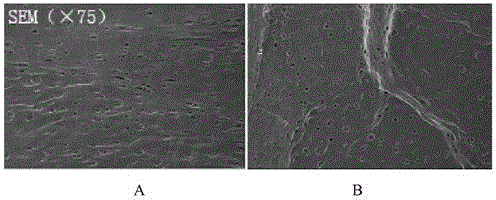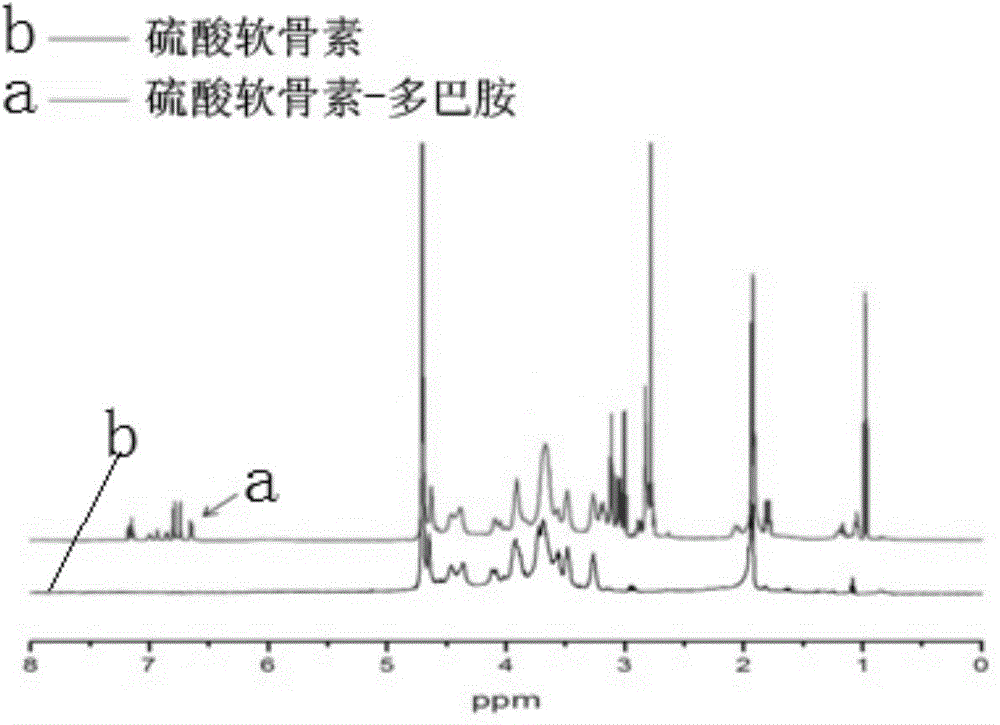Polysaccharide-dopamine composite biogel and application thereof
A technology of dopamine and biological glue, applied in the field of biological glue, can solve problems such as poor adhesion ability, and achieve the effects of reducing loss, increasing tissue viscosity, and increasing surface viscosity
- Summary
- Abstract
- Description
- Claims
- Application Information
AI Technical Summary
Problems solved by technology
Method used
Image
Examples
Embodiment 1
[0032] Example 1: Chondroitin sulfate-dopamine composite biological glue and its application
[0033] (1) Preparation of chondroitin sulfate-dopamine composite bioglue: In a nitrogen environment, add 200 mg of chondroitin sulfate sodium salt (that is, chondroitin sulfate, purchased from sigma) into 40 mL of MES buffer (0.1M, pH5.5), Stir until completely dissolved to make a polysaccharide solution. In a nitrogen environment, dissolve 218mg EDC and 247mg sulfo-NHS in 1mL MES buffer (0.1M, pH5.5), and make an EDC mixture after completely dissolved; then add the EDC mixture to the polysaccharide in a nitrogen environment In the solution, the reaction was stirred at 25°C for 30 min. 216.2 mg of dopamine was dissolved in 1 mL of MES buffer (0.1M, pH 5.5), added to the above reaction solution, and reacted for 120 minutes at 25°C under nitrogen. The product after the reaction was taken out, placed in a dialysis bag (MWCO3500), and dialyzed in distilled water for 3 days; finally, the p...
Embodiment 2
[0042] Example 2: Chondroitin sulfate-dopamine bioglue
[0043] (1) Preparation of chondroitin sulfate-dopamine bioglue: 200 mg of chondroitin sulfate was added to 40 mL of MES buffer (0.1M, pH 5.9), and stirred in a nitrogen environment until completely dissolved to prepare a polysaccharide solution. Dissolve 218 mg EDC and 247 mg sulfo-NHS in 1 mL MES buffer (0.1M, pH 5.9). After complete dissolution, an EDC mixture is obtained, which is added to the polysaccharide solution and reacted for 30 minutes at room temperature under nitrogen. 216.2 mg of dopamine was dissolved in 1 mL of MES buffer, added to the above reaction solution, and reacted for 60 minutes at room temperature (25° C.) under nitrogen. The product after the reaction was taken out, placed in a dialysis bag (MWCO3500), and dialyzed in distilled water for 3 days; finally, the product was freeze-dried (48 hours, 10Pa, -108°C) to obtain chondroitin sulfate-dopamine biojelly 192mg, And store at 4℃ in the dark.
[0044]...
Embodiment 3
[0046] Example 3: Sodium Hyaluronate-Dopamine Biogel
[0047] (1) Preparation of sodium hyaluronate-dopamine bioglue: 400 mg of sodium hyaluronate was added to 80 mL of MES buffer (0.1M, pH 5.9), and stirred in a nitrogen environment until completely dissolved to prepare a polysaccharide solution. Dissolve 437 mg EDC and 495 mg sulfo-NHS in 2 mL MES buffer (0.1M, pH 5.9). After complete dissolution, an EDC mixture is obtained, added to the polysaccharide solution, and reacted for 30 minutes at room temperature (25° C.) under nitrogen. Dissolve 432 mg of dopamine in 2 mL of MES buffer (0.1M, pH 5.9), add to the above reaction solution, and react for 60 minutes at room temperature (25° C.) under nitrogen. The product after the reaction was taken out, placed in a dialysis bag (MWCO8000~14000), and dialyzed in distilled water for 3 days; finally the product was freeze-dried (72 hours, 10Pa, -108°C) to obtain sodium hyaluronate-dopamine biogel 411mg, stored at 4°C and protected from ...
PUM
 Login to View More
Login to View More Abstract
Description
Claims
Application Information
 Login to View More
Login to View More - R&D
- Intellectual Property
- Life Sciences
- Materials
- Tech Scout
- Unparalleled Data Quality
- Higher Quality Content
- 60% Fewer Hallucinations
Browse by: Latest US Patents, China's latest patents, Technical Efficacy Thesaurus, Application Domain, Technology Topic, Popular Technical Reports.
© 2025 PatSnap. All rights reserved.Legal|Privacy policy|Modern Slavery Act Transparency Statement|Sitemap|About US| Contact US: help@patsnap.com



